Dino (automobile)
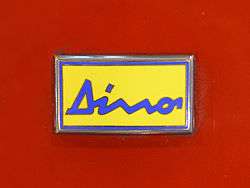 | |
| Owner | Ferrari |
|---|---|
| Country | Italy |
| Introduced | 1968 |
| Discontinued | 1976 |
| Markets | World |
Dino (Italian pronunciation: [ˈdiːno]) was a marque for mid-engined, rear-drive sports cars produced by Ferrari from 1968 to 1976. Used for models with engines with fewer than 12 cylinders, it was an attempt by the company to offer a relatively low-cost sports car. The Ferrari name remained reserved for its premium V-12 and flat 12 models until 1976, when "Dino" was retired in favour of full Ferrari branding.
Named to honour Ferrari founder Enzo Ferrari's son and heir Dino Ferrari, the Dino models used Ferrari racing naming designation of displacement and cylinder count with two digits for the size of the engine in deciliters and the third digit to represent the number of cylinders, i.e. 246 being a 2.4-litre 6-cylinder and 308 being a 3.0-litre 8-cylinder. Ferrari street models of the time used a three-digit representation of the displacement in cubic centimeters of one of the 12 cylinders, which would have been meaningless in a brand with differing numbers of cylinders.
History
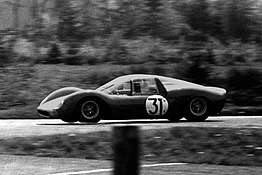
The "Dino" marque was created to market a lower priced, "affordable" sports car capable of taking on the Porsche 911. Ferrari's expensive V12s well exceeded the 911 in both performance and price. Enzo Ferrari did not want to diminish his exclusive brand with a cheaper car, so the "Dino" was created.
The name "Dino" honors the founder's late son, Alfredo "Dino" Ferrari, credited with designing the V6 engine used in the car. Along with engineer Vittorio Jano, Dino persuaded his father to produce a line of racing cars in the 1950s with V6 and V8 engines.
Ferrari wished to race in the new Formula Two category in 1967 with the Dino V6 engine. However, the company could not meet the homologation rules, which called for 500 production vehicles using the engine to be produced. Enzo Ferrari therefore asked Fiat to co-produce a sports car using the V6, and the front-engined, rear-drive Fiat Dino was born. It used a 1,987 cc (121.3 cu in) version of the Dino V6, allowing Ferrari to compete in Formula Two.
Although a mid-engine layout was common in the world of sports car racing at the time, adapting it to a production car was quite daring. Such a design placed more of the car's weight over the driven wheels, and allowed for a streamlined nose, but led to a cramped passenger compartment and more challenging handling. Lamborghini created a stir in 1966 with its mid-engined Miura, but Enzo Ferrari felt a mid-engine Ferrari would be unsafe in the hands of his customers. Eventually he partially relented, and allowed designer Sergio Pininfarina to build a mid-engined concept car for the 1965 Paris Motor Show under the Dino badge alone. The 206S, shown at Turin in 1966, bore an even closer resemblance to the production version. Response to the radically styled car was positive, so Ferrari allowed it to go into production, rationalizing the lower power of the V6 engine would result in a more manageable car.
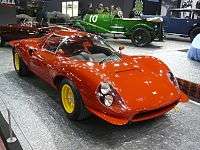 1967 Dino 206 SP, front view |
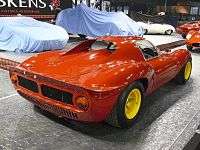 1967 Dino 206 SP, rear view |
Road cars
Dino 206 GT
| Dino 206 GT | |
|---|---|
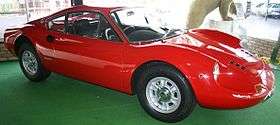 | |
| Overview | |
| Also called | Ferrari Dino 206 GT |
| Production | 1968–1969 (152 produced) |
| Designer | Leonardo Fioravanti at Pininfarina |
| Body and chassis | |
| Doors | 2 |
| Powertrain | |
| Engine | 2.0 L V6 |
| Transmission | 5-speed manual |
The first road-going Dino as well as the first Ferrari-built road car was the 1968 Dino 206 GT, designed by Leonardo Fioravanti at Pininfarina.[1]
The 206 GT used a transverse-mounted 2.0 L all-aluminium 65-degree V6 engine, with 180 PS (132 kW; 178 hp) at 8,000 rpm, the same used in the Fiat Dino. The 206 GT frame featured an aluminium body, full independent suspension, and all round disc brakes. 152 were built in total during 1968 and 1969, in left hand drive only.[2]
Dino 246 GT and GTS
| Dino 246 GT and GTS | |
|---|---|
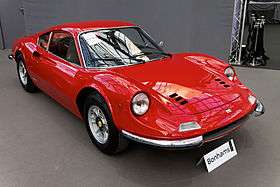 | |
| Overview | |
| Production | 1969–1974 |
| Body and chassis | |
| Body style |
Berlinetta Targa top |
| Powertrain | |
| Engine | 2.4 L V6 |
| Transmission | 5-speed manual |
In 1969 the 206 GT was superseded by the more powerful Dino 246 GT. The 246 GT was powered by an enlarged 2418 cc V6 engine, producing with 195 PS (143 kW; 192 hp) at 7,600 rpm in European specification. Initially available as a fixed-top GT coupé, a targa topped GTS was also offered after 1971.
Other notable changes from the 206 were the body, now made of steel instead of aluminium, and a 60 mm (2.4 in) longer wheelbase than the 206. Three series of the Dino 246 GT were built, with differences in wheels, windshield wiper coverage, and engine ventilation. Dino 246 production numbered 2,295 GTs and 1,274 GTSs, for a total production run of 3,569.
Dino 308 GT4 2+2
| Dino 308 GT4 2+2 | |
|---|---|
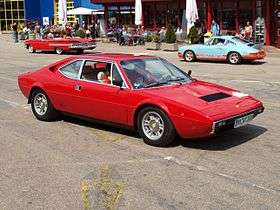 | |
| Overview | |
| Manufacturer | Ferrari |
| Production |
1973–1976 (branded as Dino) 1976–1980 (branded as Ferrari) |
| Designer | Marcello Gandini at Bertone |
| Body and chassis | |
| Body style | 2+2 coupé |
| Related | Ferrari 308 GTB |
| Powertrain | |
| Engine | 3.0 L V8 |
| Chronology | |
| Successor | Ferrari Mondial |
The 308 GT4 was produced from 1973 to April 1980. Initially branded "Dino", the 308 GT4 was Ferrari's first V-8 production automobile.
The 308 was a 2+2 with a wheelbase of 100.4 inches (2,550 mm). The 308 was designed by Bertone; with its angular wedge shape, it looked quite different from the 206/246 from which it was derived.
The 308 GT4 V-8 had a 90-degree, dual-overhead-camshaft, 2927 cc motor with 4 Weber carburetors which produced 250 hp (186 kW). The V-8 block and heads were made of an aluminum alloy. The compression ratio was 8.8:1. The American version had a timing change and an air-pump; it produced a modest 230 hp (172 kW). The GT4 weighed 2535 pounds.
The 308 GT4 wore the Dino badge until May 1976, when it finally got the Ferrari "Prancing Horse" badge on the hood, wheels, and the steering wheel.
References
- ↑ Ahlgrim, Steve (June 2014). "Amelia Island 1972 Ferrari 365 GTB/4 Daytonas". Sports Car Market. 26 (6): 67.
- ↑ Tyer, Ben. "Ferrari Dino 206 GT". Hampshire, UK: QV500.com. Archived from the original on 2016-04-04.
External links
| Wikimedia Commons has media related to Ferrari Dino. |
- Dino Register
- Club Dino Italia Ferrari, Fiat, Lancia Stratos
- Dino UK Ferrari, Fiat, Lancia Stratos
Dino car timeline, 1958–1980 | ||||||||||||||||||||||||
|---|---|---|---|---|---|---|---|---|---|---|---|---|---|---|---|---|---|---|---|---|---|---|---|---|
| Type | 1950s | 1960s | 1970s | 1980 | ||||||||||||||||||||
| 8 | 9 | 0 | 1 | 2 | 3 | 4 | 5 | 6 | 7 | 8 | 9 | 0 | 1 | 2 | 3 | 4 | 5 | 6 | 7 | 8 | 9 | 0 | ||
| 6 cylinder | Mid-engine berlinetta | 206 GT | 246 GT | |||||||||||||||||||||
| Mid-engine spider | 246 GTS | |||||||||||||||||||||||
| 8 cylinder | Mid-engine 2+2 | 308 GT4 | ||||||||||||||||||||||
| 208 GT4 | ||||||||||||||||||||||||
| Sports prototype | 196 S | 246 S | 166 P | 206 S | ||||||||||||||||||||
| 296 S | 206 SP | |||||||||||||||||||||||
| Sold as Ferrari after 1976 | ||||||||||||||||||||||||